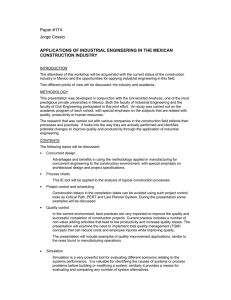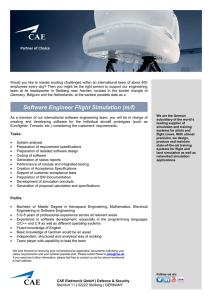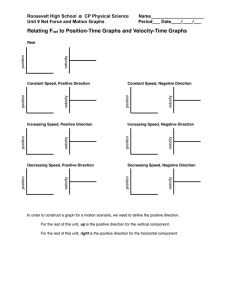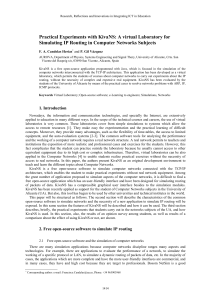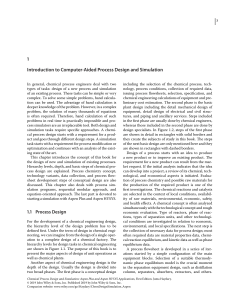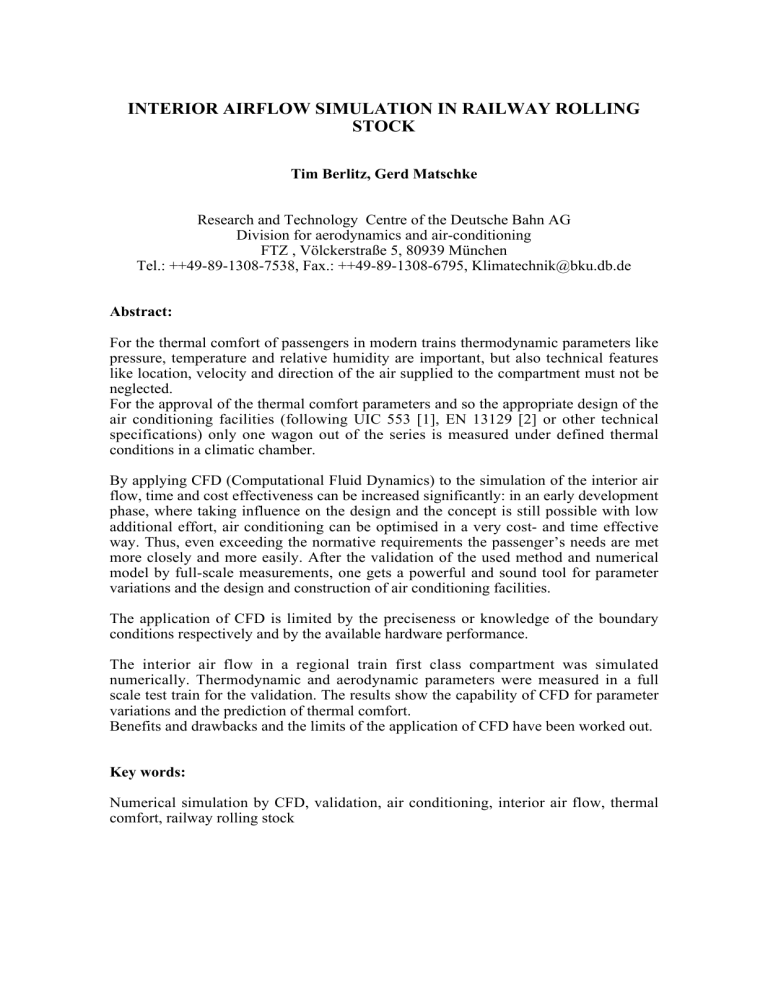
INTERIOR AIRFLOW SIMULATION IN RAILWAY ROLLING STOCK Tim Berlitz, Gerd Matschke Research and Technology Centre of the Deutsche Bahn AG Division for aerodynamics and air-conditioning FTZ , Völckerstraße 5, 80939 München Tel.: ++49-89-1308-7538, Fax.: ++49-89-1308-6795, Klimatechnik@bku.db.de Abstract: For the thermal comfort of passengers in modern trains thermodynamic parameters like pressure, temperature and relative humidity are important, but also technical features like location, velocity and direction of the air supplied to the compartment must not be neglected. For the approval of the thermal comfort parameters and so the appropriate design of the air conditioning facilities (following UIC 553 [1], EN 13129 [2] or other technical specifications) only one wagon out of the series is measured under defined thermal conditions in a climatic chamber. By applying CFD (Computational Fluid Dynamics) to the simulation of the interior air flow, time and cost effectiveness can be increased significantly: in an early development phase, where taking influence on the design and the concept is still possible with low additional effort, air conditioning can be optimised in a very cost- and time effective way. Thus, even exceeding the normative requirements the passenger’s needs are met more closely and more easily. After the validation of the used method and numerical model by full-scale measurements, one gets a powerful and sound tool for parameter variations and the design and construction of air conditioning facilities. The application of CFD is limited by the preciseness or knowledge of the boundary conditions respectively and by the available hardware performance. The interior air flow in a regional train first class compartment was simulated numerically. Thermodynamic and aerodynamic parameters were measured in a full scale test train for the validation. The results show the capability of CFD for parameter variations and the prediction of thermal comfort. Benefits and drawbacks and the limits of the application of CFD have been worked out. Key words: Numerical simulation by CFD, validation, air conditioning, interior air flow, thermal comfort, railway rolling stock 1. Introduction Standards and regulations like the UIC 533 [1] or the new EN 13129 [2] describe the thermal comfort for passengers in railway vehicles. They do not stipulate the cooling or heating power or the design of the facilities directly, they just give the acceptable limits for the different comfort parameters, i.e. what the passengers will “feel”. These parameters have to be examined in detail including their interactions among each other as well. Besides the classical functions (heating, cooling, ventilation, drying) air conditioning facilities have taken additional functions like ensuring the pressure comfort in the high speed traffic or the cooling of crucial electrical components. With these requirements complexity increased, whereas the economical boundary conditions forced the manufacturers to reduce cost and “time-to-market” , which means less time for testing and optimisation. This has lead to variegated problems, in operation and during the final functional tests in the climatic chamber before going on the track. [3] 2. Motivation For a modest and healthy climatic ambient for the passengers, one needs the possibility to test different concepts and vary miscellaneous parameters to assess the performance and effectiveness of the air conditioning facilities, before the concept is fixed and the design is frozen. Afterwards changes are very expensive or even impossible, leaving only room for adjustments rather than to improvements or optimisation of the system. With sophisticated examination of the relevant parameters on specially built full-scale models or on the ready-built vehicle, one will lack of time and money for further optimisation. The application of CFD (Computational Fluid Dynamics) enables the assessment of the thermal comfort in a very early state. With easy and fast applicable parameter variations the design and location of the facilities can be optimised and their effects on the thermal situation in the compartment can be assessed. Information is available for every point inside the vehicle and not only to discrete measurement locations. After the validation of the simulation method it can be used for various applications and vehicles. It will result in fast and cost-efficient solutions, easy to handle and complete, with all boundary conditions and interactions between the examined parts regarded. 3. Methodology All calculations were validated against full-scale experiments. The geometry was simplified for the CFD-calculations in order to save computational resources, but all main details as seats, doors, windows, luggage boards and inlet ducts were represented in an adequate manner. 3.1. Reference case and solver The simulations were performed with regional trains in operation at DB. [4]. Figure 1: Examined train in a testing operational phase The air conditioning systems were designed following UIC 553. For both train sets the first class compartments were selected for the validation. To further reduce the required cell number for the simulation in one case, only half of the compartment was simulated and a longitudinal symmetry was assumed. The geometry data was supplied by the car manufacturers, either as 2D or 3D-file. It was adapted to the requirements and cleaned up before the surface grid was created. Second step was to build the hybrid volume mesh, with its structure depending on the needs of the simulation. The CFD-software used was Fluent [5], with a standard k-ε turbulence model. For determining the heat transfer through the walls the corresponding coefficients were calculated by Fluent, using the boundary conditions (air-velocity, temperature), occurring in the specific measuring program for the approval in the climatic chamber for railway vehicles in Vienna. For the unknown boundary conditions suitable assumptions were drawn: Walls, windows and the floor were taken as homogeneous, the specific heat transfer coefficient was taken as constant over the thickness (1Dsimulation). Characteristic material values were taken from literature [6][7]. 3.2. Validation of temperatures For the reference case boundary conditions were fixed at –11 °C exterior temperature and wind velocity of 13 km/h. The side wall convectors supplied the main part of the heat, a small part was delivered by the fresh air inlets. Besides the common temperature sensors an infrared camera was used for the surface temperatures. Interior temperatures For ensuring the relevance of the symmetry assumption an equidistant temperature gauge chain was built up horizontally (1 = left, 12 = right). For the temperature stratification a vertical temperature gauge chain was installed. Figure 2 answers the question about the symmetry: The horizontal temperature gauge chain shows a very good fit between measurement data and numerical results, in absolute values and for the temperature differences. Based on the measured temperatures the maximum deviation of the numerical results from the measurement is about 0.3 %. Point 1 and 12 at the walls have the largest deviation, which decreases with increasing wall distance. For the vertical temperature measuring chain numerical results were in good conformity with the measurements, as it can be seen in figure 3. Very close to the wall, especially above the heating rod (0,4 m height), significant deviations occurred: The used model in the simulation reproduced the heating power exactly, but the temperatures were higher than in reality, due to simplifications in the geometry. Further improvements will be gained with a more precise modelling of the heating rod. 28 27 T [°C] 26 25 24 23 22 1 2 3 4 5 6 7 Measuring Point Measuring 8 9 10 11 Simulation Figure 2: Comparison of simulation and measurements, horizontal temperatures 12 28 27 Temp in °C 26 25 24 23 22 0,2 0,4 0,6 0,8 1 1,2 1,4 1,6 1,8 Height in m Measuring Simulation Figure 3: Comparison of simulation and measurements, vertical temperatures For the average mean of the room temperature the predictability was also very good: Measured value was 24.8 °C (with a uncertainty of the used temperature gauges of 0.3 K) compared to 25.3 °C (simulation result). Surface temperatures: Wall temperatures were in good accordance with the simulation, especially at places far from heat sources. Larger deviations could be found directly on the windows and between the windows on the wall. Table 1 lists the wall temperatures at the drivers cab door. Accordance between measurements and simulation is very good for the absolute values and the temperature differences as well: Height over floor 0,3 m 0,6 m 0,9 m 1,2 m 1,5 m Simulation Measurements 23,8°C 23,7°C 24,2°C 24,2°C 24,4°C 24,5°C 24,8°C 24,8°C 25,3°C 25,4°C ∆T Simulation: ∆T Measurements: 0,4 K 0,5 K 0,2 K 0,3 K 0,4 K 0,3 K 0,5 K 0,6 K Table 1: Temperatures and temperature differences on the wall at the driver’s cab, from bottom to top Additional infrared (IR) pictures confirmed the results of the measurements and computations. 3.3. Validation of air flow In parallel to the simulation and measurements of the temperatures, the air flow was examined. The simulation´s result can be seen in figure 4: Figure 4: Pathlines in the compartment, coloured by velocity, ejected from the inlet in the ceiling and passing from left to right One detects an unfavourable flow pattern: The major part of the incoming air moves along the ceiling to the passenger’s entrance area, another part is directly sucked off from the laterally attached waste air slots. Thus only a small part of the supply air reaches the entire passenger compartment. The reason is that in the special heating mode (part of the approval measuring program), the air velocities were too low to attain a good distribution. A visualisation with smoke propagation revealed the numerical results. The boundary conditions on the air outlets could not be measured precisely in the full scale train and therefore were modelled only in a simplified way. As one can assume the airflow to be inhomogeneous and turbulent along the nozzle (but was taken constant in the simulation) a good quantitative prediction of local flow fields was difficult, although the global behaviour of the flow field was reproduced in a good manner (with the air streaming from the upper level to the entrance part of the compartment). For the additional validation of the simulations regarding the air flow, another train set with a high floor first class compartment was chosen. In contrary to the temperature validation the measurements were performed in the cooling mode. At the outlet and in the region below the outlet, where the flow was assumed to be turbulent, the numerical grid was refined for more sophisticated examinations. Measurements The air flow measurements were of two kind: a qualitative determination of the flow field with laser light-cut (LLI) and/or smoke propagation and a quantitative flow-field measurement with 1-D velocity sensors and LDA (Laser Doppler Velocimetry), enabling a two-dimensional velocity determination. As the compartment was physically separated from the rest of the train by doors, it was assumed, that there were no shares of the air flow in lateral direction (y-axis), which means, that only the x- and z- share of the velocity vector (in the y-plane vertical to the trains lateral axis) were measured; to improve the accuracy of the simulation, it is crucial to examine the inlet flow field first, which serves as a starting parameter for the simulation. Flow Visualisation The evaluation of the measurement data showed a strongly time-dependent behaviour and a more or less highly 3-dimensional flow pattern. At almost all measuring points apart from the x and z-component also a more or less strongly developed y-component was determined. Side walls were at x = ± 1300 mm Position of the video camera with detected airflow Z [m m] 2500 2000 1500 1000 500 0 -1500 -1000 -500 0 500 1000 1500 X [mm] Figure 5: Summary of the visualisation of the flow patterns in the measuring plane Only near the window the flow is bounded downwards, in the rest of the measuring plane the air flow goes up to the roof, where the waste air is sucked off. In between the flow pattern is more or less turbulent, the y-component is not negligible. Air-velocity determination First measurements of the inlet air flows showed, that the distribution of the inlet air was very uneven, which resulted in some parts in very high inlet velocities (3,5 m/s), whereas it attained zero in other parts. The flow samples measured by the laser Doppler velocity meter show a turbulent flow pattern along the windows and a range of small air velocities up to a unsteady behaviour in the downward flow beneath the windows and directly under the air-inlet. In figure 6 the absolute value of the velocity vector (x- and z- component only) is shown: Near the wall beneath the window the air speed is about 0,4-0,5 m/s, in the middle somewhat between zero and 0,3 m/s. 0,4 0,2 -1400 -900 -400 100 600 1100 0,0 -0,2 -0,4 -0,6 Figure 6: Absolute value of the velocity vector in m/s along the width of the vehicle in a height of 1000 mm: -1300 mm is left wall, + 1300 mm is the right wall. Simulation results A preliminary simulation of the air flow in the vehicle to get first results and informations about the quality of the grid was performed. For the air velocity the mean value calculated by the designed amount of supply air was used together with the assumption of an even distribution along the air ducts. Results can be seen in figure 7. It shows the interior of the first class compartment with a virtual surface containing the velocity vectors of the flow field, couloured by velocity magnitude: the position of the surface is exactly, where the measurements were performed. Although there seems to be a rather good conformance with the measurements displayed in figure 5 and 6 (same range for the velocity in the interior, upstream in the middle and at the top, downstream at the side walls), one cannot draw any reliable conclusion, as long as the exact boundary and starting conditions are not known. However, it is obvious, that refinement of the grid is necessary at the outlet ducts near the window, where the airflow is highly turbulent. Figure 7: First class compartment of a regional train with an implemented virtual surface displaying the velocity vectors of the air flow. The small velocity of 0.01 m/s is displayed blue, the higher velocity of 0.8 m/s is coloured red. Next step will be the determination of the appropriate boundary conditions, i.e. the exact air flow (direction and absolute value) at the air ducts. With these input parameters sound and reliable results about the local behaviour of the interior air flow will be attained. 4. Discussion of the results The measured temperatures were in good compliance with the calculated values. Partially stronger deviations did only occur near the wall above the heating convectors and at the outlets of the ducts. Two facts are mainly responsible for these effects: the performed simplification of the structure of the geometry and the application of general boundary conditions at places, where the exact values were not available. With increasing distance to these disturbance sources, results were gaining reliability again. Occurring leakage and bad assumptions for the operating conditions (heating capacity, inlet velocities) and characteristic material values (k-value, wall structure) can influence the simulation negatively, if they are not regarded properly, e.g. by a detailed investigation in advance. The exact knowledge of boundary conditions and geometry is a prerequisite for accurate results. The assumption of the symmetry and thus the reduction of the regarded area to one half had, just as the not simulated small details in the interior, a negligible influence on the result. 5. Conclusions and further proceeding The suitability of numerical simulations for the prediction of temperature distributions and air flows in the interior of railway vehicles was examined, the methodology for the computation of the thermal comfort of a railway vehicle was defined. Results show a good agreement to the full scale measurements, performed in the climatic chamber. A careful modelling, in particular near the wall and in the edges, as well as an adapted discretization of the computational domain are crucial for reliable and sound results. One the other hand, when using CFD as an optimisation tool in the design phase and knowing about the strong influence of the boundary conditions on the whole thermal performance of the vehicle, one has to assure more carefully than at present, that the design parameters (e.g. concerning homogeneity of the air flow along the outlets) are also realised in the real train. CFD here gives precious information on what will happen if the design requirements are not fulfilled in the construction. Correctly applied, the numeric simulation with CFD methods will give first, basic predictions about the thermal comfort and thus represents an innovative and valuable tool for interpretation and optimisation of climatic systems in complex scenarios such as railway vehicles. Its application will shorten design time and so cost and it will help to optimise the whole system of air conditioning. CFD will not totally replace the full scale measurements, but it will be a good supplement. Further simulations and measurements will be performed. This includes the optimisation of the simulation models and the validation of the results with the reference data coming from the full scale tests. For the airflow validation the simulation will be performed, regarding the relevant input data from the full scale measurements. Next steps will be the simulation of relative humidity, direct solar radiation and CO2content. An assessment of the human felt comfort shall be included, to get information about the influence of the thermal parameters on the passengers comfort. Part of these works will be performed in a project funded by the European Community, called “Simulation of thermal comfort in trains”, where a generic code including the assessment of the thermal comfort, will be developed and validated in well defined experimental and functional tests. 6. Units, abbreviations ∆T °C K Temperature difference Temperature in °Celsius Temperature in Kelvin h k-value m m2 m3 Hour Heat transition coefficient in [W/m_K] Meter Squaremeter Cubicmeter 1-D CFD CO2 EN ET IR LLI LDA UIC VT One-dimensional Computational Fluid Dynamics Carbon dioxide European Norm Electro-Traction InfraRed Laser-Light Cut Laser-Doppler-velocimeter Union International de Chemin de fer Verbrennungs-Traktion (Diesel-Traction) 7. Bibliography [1] UIC-Merkblatt 553: Heizung, Lüftung und Klimatisierung von Reisezugwagen [2] PrEN 13129–1: Luftbehandlung in Schienenfahrzeugen des Fernverkehrs, German version from 1998, preliminary draft [3] M. Petz, Klimatisierung von Schienenfahrzeugen und Omnibussen, Presentation on the 5th Karlsruher Fahrzeugklima-Symposium, 6th of march 1998. [4] Stiefel, Dwelk: Der TALENT: erprobte Nahverkehrstechnik der Waggonfabrik Talbot. In: Eisenbahntechnische Rundschau, Heft 5, 1997 [5] FLUENT 5 User´s Guide. Volume 1-4. FLUENT Incorporated, 1998 [6] H. Kuchling: Taschenbuch der Physik, 16. Auflage. Fachbuchverlag Leipzig, 1999 [7] Morgenstern, Richter, Henning: Wärmeverlustanalyse und k-Wert-Berechnung für Reisezugwagen. In: Eisenbahntechnische Rundschau, Heft 1-2, 1997
